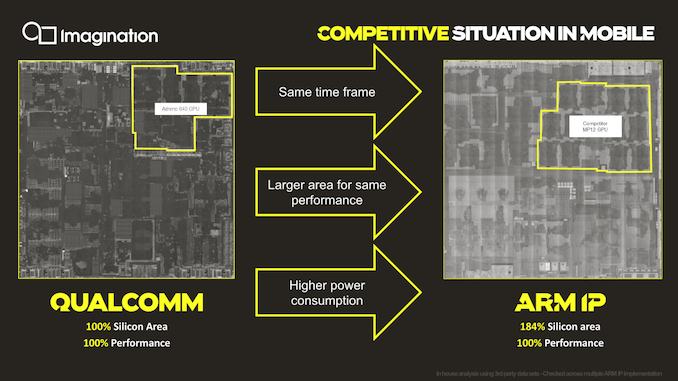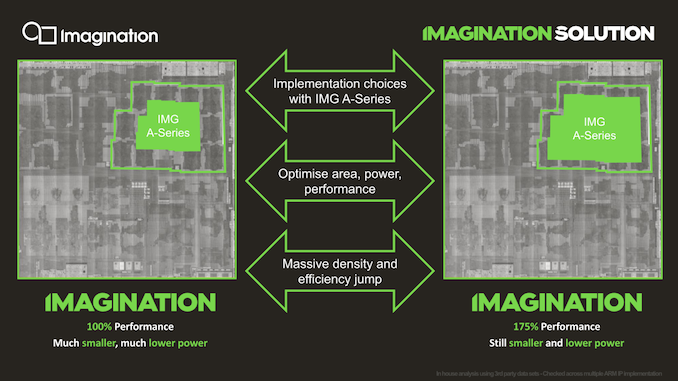Imagination Announces A-Series GPU Architecture: "Most Important Launch in 15 Years"
by Andrei Frumusanu on December 2, 2019 8:00 PM ESTPPA Projections - Significant, If Delivered
Moving on, the A-Series improvements don’t mean much if we can’t put them into context in the competitive landscape.
As mentioned in the introduction, Imagination seem aware of the current PPA deficit that GPU vendor IP offers versus custom designs by more vertically integrated SoC vendors.
Starting off with a comparison between current generation Qualcomm GPU against an Arm GPU. Imagination didn’t specifically mention which designs we’re talking about here, but we do clearly see from the die shots that the SoCs being compared are the Snapdragon 855 and the Exynos 9820.
Here Imagination describes that for a similar performance level, Arm’s Mali GPUs are using ~184% the silicon area compared to Qualcomm’s Adreno implementation.
I do have some doubts about the validity of the comparison being made here, as these SoCs were not made on the same process node – Qualcomm's design is built on TSMC's denser 7nm process, while Samsung's Exynos uses their larger 8nm process. With that in mind, we take the metrics presented with a huge grain of salt as Imagination does say the figures are based on analysis of multiple Arm IP implementations rather than a single data-point.
Projecting the A-Series against a current Mali-G76 implementation, targeting a performance level equivalent to current generation flagship implementations (~100fps in Manhattan 3.0), an A-Series GPU would achieve a significantly smaller GPU implementation requiring much less die area. The comparison implementation here would be an AXT-16-512 implementation running at slightly lower than nominal clock and voltage (in order to match the performance).
If a customer were to choose to use more die area to go wider and slower in clock (more efficient), while still maintaining an estimated area that would be smaller than a Mali GPU, it would roughly achieve a 75% performance advantage. The comparison here would be an AXT-32-1024 running quite far below nominal, giving it a large power efficiency advantage.
Of course, Imagination’s comparison here were made against the current generation Qualcomm and Arm GPUs, which aren't what it'll actually be competing against. Instead, by the time A-series SoCs ship, it will be competing against the next-generation Adreno as well as Mali-G77. We know Arm’s promised goals for the G77 and the improvements in performance per mm² and performance perf/W is around 1.2-1.4x, which we could generalize to 1.3x. Samsung’s upcoming Exynos 990 only promises a 20% performance increase, which is slightly below this projection. On the Qualcomm side and the upcoming Adreno generation, we’ll have to wait a few more days to be able to talk about details, but generally we expect improvements in the same ballpark.
Fortunately for Imagination, the projected PPA figures and advantages for the A-Series are high enough that they would still be notably ahead of both Qualcomm and Arm’s upcoming next generation GPUs, keeping a comfortable lead in either GPU area, or performance, depending on the configuration.
So far everything looks quite splendid – what remains to be seen if Imagination and their licensees are able to deliver on the projected figures.












143 Comments
View All Comments
Etain05 - Tuesday, December 3, 2019 - link
I think that’s for tablets, and the AXT-64-2048 is just a possible option. If you want to consider the AXT-48-1536, you’d have to compare it to the A12X and whatever comes next.vladx - Wednesday, December 4, 2019 - link
Well B series should be available to customers in 2020 so a BXT-32-1024 should crush the A14 assuming the 30% improvements will be accomplished.Etain05 - Wednesday, December 4, 2019 - link
The A series will be in devices in the second half of 2020, there’s absolutely no way that the B series will be available to customers in 2020. The B series will be available in 2021, when it will compete with the A15.vladx - Wednesday, December 4, 2019 - link
By customers I meant SoC manufacturers, like MediaTek and phones using B-series SocS could be made available before A15 since Apple releases new phones in Q4 usually.Etain05 - Wednesday, December 4, 2019 - link
Even if we were to be generous in our assumptions, the soonest we’ll see any device with a B-series would be Q3 2021, so at most a few months before the A15. The competition would still be the A15, not the A14. Even more importantly, there’s almost no smartphone that comes out in Q3, apart from some in August and September, which is exactly the time when the A15 will be out too.rbanffy - Tuesday, December 3, 2019 - link
It's still a numeric naming scheme. 0xA comes after 0x9, after all.mode_13h - Wednesday, December 4, 2019 - link
Yeah, but he asked and they denied it. They should've been like "hey... yeah! yeah, that's exactly right!", except the question was probably fielded by an ignorant marketing drone who doesn't know about hexadecimal.In fact, maybe whoever actually thought of the naming scheme planned it exactly like that, but that reasoning somehow failed to get communicated.
domboy - Tuesday, December 3, 2019 - link
Oh... so they aren't announcing a new Kyro video card... oh well... :/mode_13h - Wednesday, December 4, 2019 - link
Nice one. At first, I thought you confused it with Qualcomm's "Kryo" cores, but misspelled it.https://en.wikipedia.org/wiki/PowerVR#Series3_(STM...
https://en.wikipedia.org/wiki/Kryo
wrkingclass_hero - Tuesday, December 3, 2019 - link
I wish them success and hope to see them get plenty of design wins. I have never actually owned a PowerVR product, but I've been sort of a distant fan (over here in Android land) and look forward to seeing how they perform. If they do well, who knows, they may even reenter the console market with the next-gen portables.